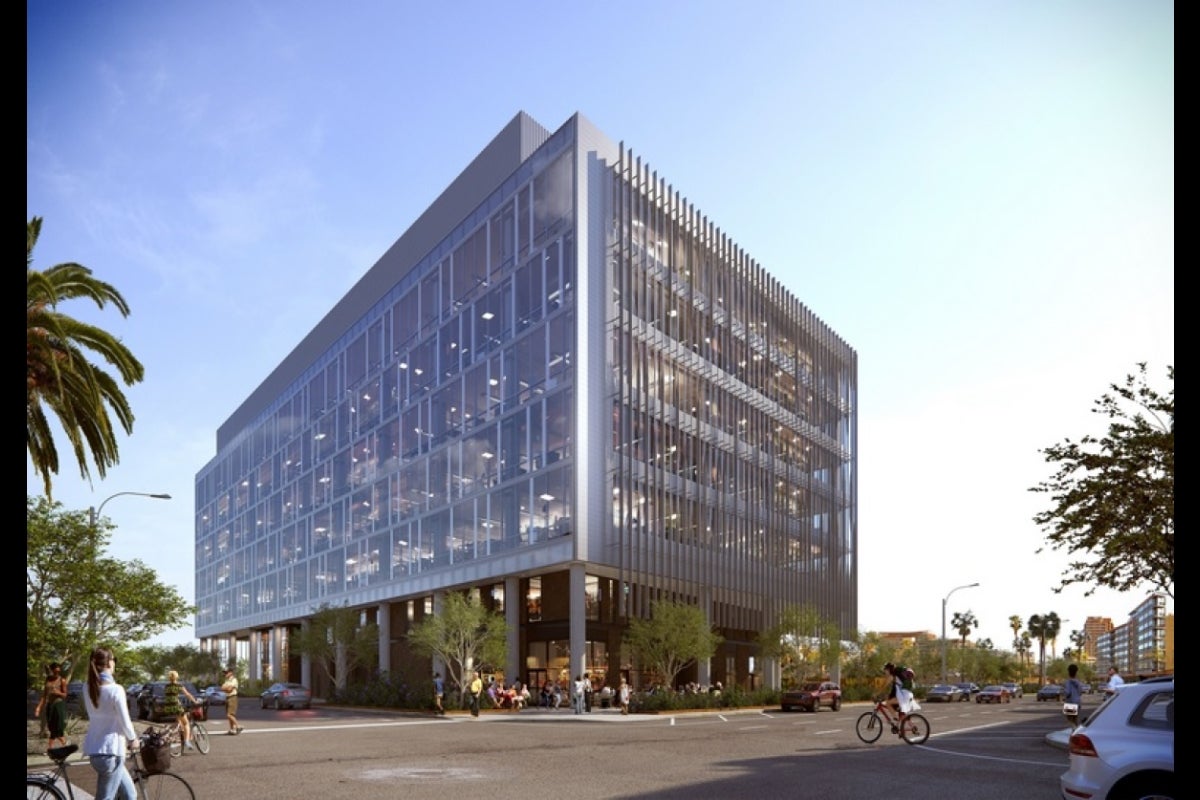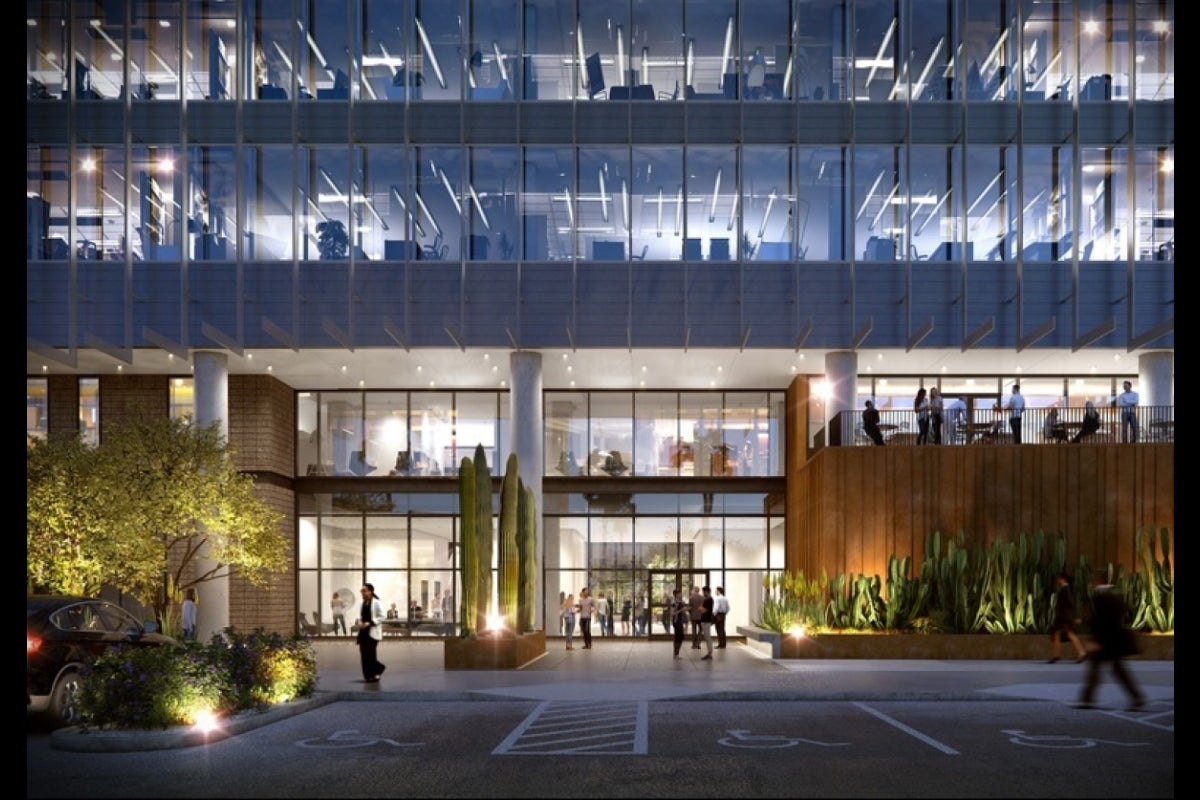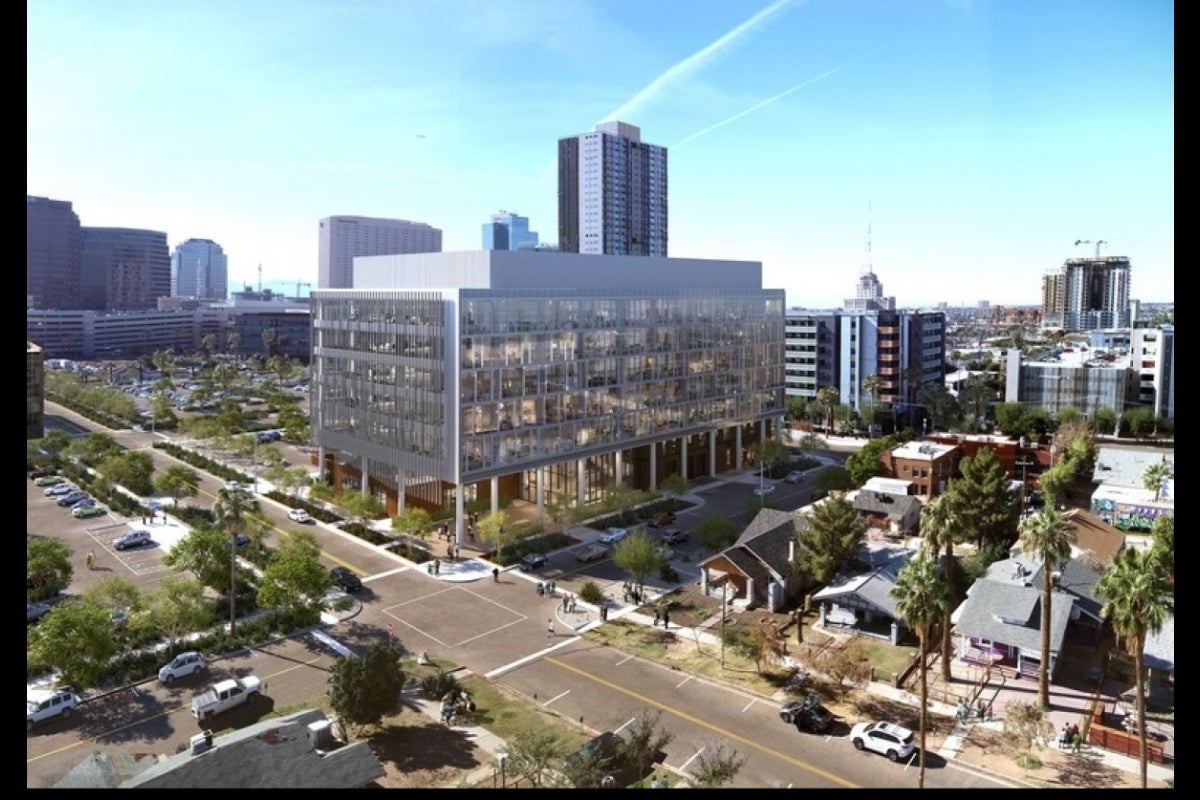The din of construction on the northeast corner of Garfield and Fifth streets in downtown Phoenix will soon give way to a flurry of activity as the researchers and entrepreneurs who will inhabit half of the new 225,000-square-foot building that now stands there move in to embark on journeys of discovery and advancement that promise to enhance the health and vibrancy of the surrounding community.
Wexford Phoenix Biomedical Campus Building 1 (PBC1) broke ground in 2019 after Arizona State University, the city of Phoenix and real estate development company Wexford Science and Technology saw an opportunity to bridge the surrounding neighborhoods, the academic community and the professional community through research, entrepreneurial activity and corporate engagement to create a thriving knowledge community.
As ASU President Michael Crow noted during a virtual ribbon-cutting ceremony March 30, despite the pandemic, great progress is still being made.
“This building is the beginning of a new kind of energy in downtown Phoenix,” Crow said. “(One where) private sector companies are clustering around scientists, around nurses, around physicians, around students, around dreamers, engineers, creative people, entrepreneurial people, innovative people.”
The $77 million state-of-the-art facility is the first piece of a 7-acre parcel ASU is responsible for on the city-owned Phoenix Biomedical Campus, a 30-acre area in the heart of downtown that was established in 2004 by an initiative between the city, the Arizona Board of Regents and the state’s public universities to expand medical education and research in the Phoenix metropolitan area.
Phoenix Mayor Kate Gallego shared her hopes Tuesday for PBC1 to take the downtown biomedical campus and the city’s entrepreneurial ecosystem to the next level as one of the top five emerging bioscience areas in the country.
“This is place that you want to work, where you're going to come up with the next cure for cancer, which I'm convinced is coming through the downtown biomedical campus,” Gallego said.
ASU will lease approximately 112,000 square feet — half of the building — for 15 years with three five-year options. The remainder of the building will be occupied by private-sector companies, a fact that organizers expect will be the secret sauce in forging the kind of discovery and innovation that can have a real impact on the community.
Wexford Science and Technology exclusively partners with universities, academic medical centers and research institutions to develop mixed-use, amenity-rich knowledge communities. The company’s portfolio extends across nine states and includes projects in Philadelphia, Chicago, St. Louis, Miami and Baltimore.
Thomas Osha, Wexford Science and Technology’s senior vice president for innovation and economic development, said it’s no accident that the new building in downtown Phoenix is located in the middle of a diverse urban area and is right next to the Roosevelt Row Arts District.
“Innovation districts aren't exclusive, walled campuses,” Osha said. “They're porous, they’re open, they’re inviting, and they’re creating inclusive opportunities for residents of the entire area, and at all levels.”
The building itself features 240,000 square feet of wet and dry labs, office and retail space, and is LEED Gold certified. Global design firm HKS served as the architect and interior designer for the project, which was inspired by the saguaro cactus, native to the Sonoran Desert in which PBC1 is located.
"Like the saguaro," HKS' website states, "the building facade combats the arid climate conditions with geometric ribs that shade the structure and help mitigate the effects of the extreme solar radiation. ... The materials used for the exterior are primarily concrete, weathered steel and brick, which are slow to warm up during the day and dissipate the heat."
One of PBC1's first tenants is the company OncoMyx, a spinout from research previously done at ASU that is working to develop oncolyticAn oncolytic virus is a virus that preferentially infects and kills cancer cells. immunotherapies with the goal of achieving the greatest therapeutic benefit for more cancer patients.
OncoMyx CEO and co-founder Steve Potts shared his view for the company to leverage the resources afforded by the new facility to put them in the position to fill a valuable void in the biomedical innovation landscape.
“If you think of the biomedical space, especially the space that's generating intellectual property assets ... the industry is really a tripod,” Potts said. That tripod is made up of diagnostics, medical devices and pharmaceutical drug development. Arizona is known for its strength in the first two; Potts hopes his company will help prop up the third, thanks to the Wexford building’s myriad assets, not least of all its ability to entice new employees with proximity to industry and travel, and a lower cost of living compared to other biotech hubs.
And, Potts said, “In terms of the lab and the office balance, it's hard to find a facility like this, that's this modern and kind of just built for life science firms, even if you go to San Francisco or Boston. It's a beautiful building, it's really well-built for … anybody doing life sciences. … I find it just a great place to build companies.”
Researchers who will share space in PBC1 will come from all across ASU, including the College of Health Solutions, the Edson College of Nursing and Health Innovation and the Biodesign Institute.
Frank LoVecchio, who recently joined ASU as the medical director of clinical and community translational research, will be on hand to provide medical oversight for much of that research.
“The research we’ll be doing here is really going to take us to the next step in doing what's best for the patients, and that's the people of Arizona,” LoVecchio said.
One project he is currently overseeing involves College of Health Solutions Professor Scott Leischow, who also serves as the director of clinical and translational science for the college, and is looking at a new smoking cessation drug, using volunteers from the community as study participants.
The building will also have space for the J. Orin Edson Entrepreneurship and Innovation Institute.
“As the pan-university and pan-community resource for ASU students, faculty, staff, alumni and the greater community, we work in collaboration with community partners like the Flinn Foundation, the Center for Entrepreneurial Innovation, StartupAZ, Greater Phoenix Economic Council and many others to support innovators and entrepreneurs,” said Ji Mi Choi, vice president of ASU Knowledge Enterprise. “… The power of place is in bringing together ideas and people for connectivity, collaborations and positive collisions.”
And even though ASU does not have a medical school, College of Health Solutions Dean Deborah Helitzer sees PBC1 and the work that will be done there as an opportunity to take advantage of the new direction modern medicine is taking.
“Traditionally, when we think about biomedical research and education, we think about medical schools,” Helitzer said. “But more and more today, health care is delivered in an ambulatory, or outpatient, environment. So the Phoenix Biomedical Campus, anchored by ASU and its downtown colleges, has the advantage of being a location with multiple organizations and entities. … There's no other place in the country that has this kind of ecosystem.”
More Science and technology

Breakthrough copper alloy achieves unprecedented high-temperature performance
A team of researchers from Arizona State University, the U.S. Army Research Laboratory, Lehigh University and Louisiana State University has developed a groundbreaking high-temperature copper alloy…

4 ASU researchers named senior members of the National Academy of Inventors
The National Academy of Inventors recently named four Arizona State University researchers as senior members to the prestigious organization.Professor Qiang Chen and associate professors Matthew…

Transforming Arizona’s highways for a smoother drive
Imagine you’re driving down a smooth stretch of road. Your tires have firm traction. There are no potholes you need to swerve to avoid. Your suspension feels responsive. You’re relaxed and focused on…





